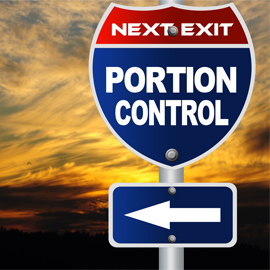Portion Control for Weight Loss
 Healthy eating habits are necessary for long-term weight management. While other lifestyle changes, like exercising more and finding new ways to deal with stress support weight loss, managing daily food intake is especially important.
Healthy eating habits are necessary for long-term weight management. While other lifestyle changes, like exercising more and finding new ways to deal with stress support weight loss, managing daily food intake is especially important.
Choosing an appropriate amount of healthy foods that contain the right balance of nutrients is essential to medical weight loss. Adopting good portion control habits is one technique you can use to encourage weight loss as you develop a healthier lifestyle.
The Problem with Eating Too Much
From eating out to ordering in, we have access to all kinds of food at all hours of the day; and this can lead to overeating simply because food is available. Along with increased access to food, restaurants usually offer meals with large portions, which many people feel compelled to eat. When you consume more calories than your body normally uses, you’ll gain weight.
Being overweight has many detrimental effects, including increased risk for:
- Type-2 diabetes
- High cholesterol
- High blood pressure
- Cancer
- Heart disease
- Stroke
- Breathing problems
Eating to Live
The body needs food to survive, but giving it overly processed foods that are high in sugars, fats, oils and sodium will only cause health to deteriorate. “Eating to live” means choosing foods that support optimum health and work well with medical weight loss goals.
Home-prepared meals give you complete control over the contents, portions and cooking methods, which contribute to proper portion control. Buying whole grains, fresh fruits and vegetables, low-fat dairy and lean protein sources makes the kitchen a haven of health and supports healthy eating behaviors.
Make Portions Count
Having healthy food available is essential, but portions are still important. Reading nutrition labels or relying on apps like “Lose It” or “My Plate” can help you know the caloric and nutritional content of any food item. An entire package often contains several servings, so make sure you understand how much a single serving is.
Daily meal plans will help organize portions, allowing you to design meals around daily caloric and nutrient needs. Depending on the medical weight loss program, requirements for lean proteins or restrictions on fats may vary.
Here are some tips for portion control:
- Pre-portion meals in advance and store them in the fridge or freezer for later use
- Remove one serving size from packaged food containers and then put the package away
- Order a half size when available or take half your meal in a to-go box when dining out
- Don’t skip meals, as this can cause you to become overly hungry
- Pay attention to when and how much you eat
- Make the kitchen friendly by having fruits, vegetables and healthy snacks within reach, and storing tempting foods in hard-to-reach places
Developing better portion control, along with making a habit of choosing healthy foods, will help support your overall medical weight loss goals and provide your body with more of the nutritious foods it needs to stay healthy.


